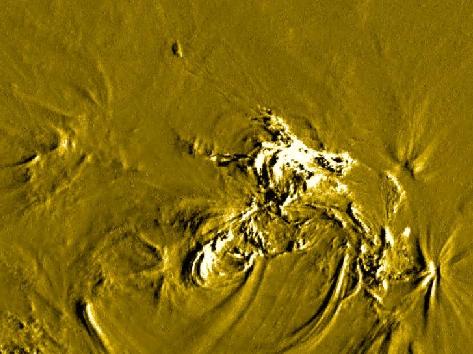It looks like you're using an Ad Blocker.
Please white-list or disable AboveTopSecret.com in your ad-blocking tool.
Thank you.
Some features of ATS will be disabled while you continue to use an ad-blocker.
2
share:
We've heard of 'hollow Moon' and 'hollow Earth' theories. But what about the theory of a 'solid' sun?
What is the Sun made of? Spectroscopy shows that hydrogen makes up about 94% of the solar material, helium makes up about 6% of the Sun, and all the other elements make up just 0.13% (with oxygen, carbon, and nitrogen the three most abundant 'metals'---they make up 0.11%.
Well that's what we learned at school! But with the latest satellite imagery, it seems the sun may be a solid sphere after all!!
This is an example of a "running difference" image of the sun's
surface revealed by the TRACE satellite using its 171 angstrom filter.
This filter is specifically sensitive to iron ion (FE IX/X) emissions and
records a C3.3 flare and mass ejection in AR 9143 in 171Å on 28 Aug 2000.
The flare activity is caused by increased electrical activity as fast moving plasma
sweeps over surface ridges, resulting in increased electrical activity on the
windward side of the mountain ranges.
Courtesy: 'The Surface Of The Sun'
So now we have not one, but two models, thanks to TRACE and SOHO. The image above taken by the TRACE satellite, does seem to show a solid surface.
I guess we'll have to wait a little longer as the jury seems out on this one!
www.thesurfaceofthesun.com...
What is the Sun made of? Spectroscopy shows that hydrogen makes up about 94% of the solar material, helium makes up about 6% of the Sun, and all the other elements make up just 0.13% (with oxygen, carbon, and nitrogen the three most abundant 'metals'---they make up 0.11%.
Well that's what we learned at school! But with the latest satellite imagery, it seems the sun may be a solid sphere after all!!
The sun's photosphere is often mistakenly referred to as the 'surface' of the sun. In reality however, the sun's photosphere is only a "liquid-like" plasma layer made of neon that covers the actual surface of the sun.
That visible layer we see with our eyes is more commonly known as penumbral filaments. This visible neon plasma layer, as well as a thicker, deeper plasma layer of silicon, entirely covers the actual rocky, calcium ferrite surface layer of the sun. The visible photosphere covers the transitional region that is the actual surface of the sun, much as the earth's oceans cover most of the surface of the earth.
This is an example of a "running difference" image of the sun's
surface revealed by the TRACE satellite using its 171 angstrom filter.
This filter is specifically sensitive to iron ion (FE IX/X) emissions and
records a C3.3 flare and mass ejection in AR 9143 in 171Å on 28 Aug 2000.
The flare activity is caused by increased electrical activity as fast moving plasma
sweeps over surface ridges, resulting in increased electrical activity on the
windward side of the mountain ranges.
Courtesy: 'The Surface Of The Sun'
There are a whole host of unexplained phenomena related to the sun's activities that still baffle gas model theorists to this day because they fail to recognize the existence of an iron alloy transitional layer that rests beneath the visible photosphere. Fortunately a host of new satellites and the field of heliosiesmology are starting to shed new light on this mysterious transitional layer of the sun that is located about 4800km beneath the visible photosphere.
So now we have not one, but two models, thanks to TRACE and SOHO. The image above taken by the TRACE satellite, does seem to show a solid surface.
I guess we'll have to wait a little longer as the jury seems out on this one!
www.thesurfaceofthesun.com...
i just think its amazing how much info we learn that is simply not true, just to show that we can learn a certain way to adapt to adult life.
I just think it's amazing how much info we take at face value without even bothering to look into it. As far as I can see, the only "evidence"
given here is a couple of badly interpreted satellite images. No explanation as to how any solid whatsoever can survive at temperatures of 5500+ K.
I have always thought the sun was a gaseous,glob of molten lava..
There are many mysteries about the sun that we will never know because its heat radiates such that any in-depth analysis of it is just not possible.
The Sun's Mysteries
There are many mysteries about the sun that we will never know because its heat radiates such that any in-depth analysis of it is just not possible.
The Sun's Mysteries
new topics
-
An Interesting Conversation with ChatGPT
Science & Technology: 3 hours ago
top topics
-
Have you noticed?? Post Election news coverage...
World War Three: 16 hours ago, 12 flags -
Squirrels becoming predators
Fragile Earth: 15 hours ago, 10 flags -
Drone Shooting Arrest - Walmart Involved
Mainstream News: 14 hours ago, 10 flags -
World's Best Christmas Lights!
General Chit Chat: 13 hours ago, 8 flags -
Can someone 'splain me like I'm 5. Blockchain?
Science & Technology: 14 hours ago, 7 flags -
Labour's Anti-Corruption Minister Named in Bangladesh Corruption Court Papers
Regional Politics: 16 hours ago, 6 flags -
An Interesting Conversation with ChatGPT
Science & Technology: 3 hours ago, 3 flags
2

